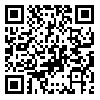Volume 12, Issue 2 (Volume12, Issue 2 2024)
CPJ 2024, 12(2): 13-26 |
Back to browse issues page
Ethics code: IR.SBU.REC.1401,083
Download citation:
BibTeX | RIS | EndNote | Medlars | ProCite | Reference Manager | RefWorks
Send citation to:



BibTeX | RIS | EndNote | Medlars | ProCite | Reference Manager | RefWorks
Send citation to:
Golkar G, Borhani K, Gharibzadeh S. The effect of wearing a face mask during the covid-19 pandemic on face perception in children with autism spectrum disorder. CPJ 2024; 12 (2) :13-26
URL: http://jcp.khu.ac.ir/article-1-3817-en.html
URL: http://jcp.khu.ac.ir/article-1-3817-en.html
Shahid Beheshti University of Tehran , kh_borhani@sbu.ac.ir
Abstract: (4391 Views)
The purpose of this study is to investigate the effect of wearing a face mask on face perception in children with autism spectrum disorders. 18 children (13 boys, 5 girls) with high functioning autism and normal intelligence in the age range of 7 to 12 years old (Mage = 9.917, SD = 1.7342) participated in the research using an available sampling method. The participants in this research performed a face recognition and discrimination task that included familiar and unfamiliar faces for the child. During the task, the number and duration of fixations in the areas of interest (AOI) were recorded by an eye tracker. Finally, the dependent t-test method was used to analyze the collected data. The results showed that when comparing familiar and unfamiliar faces with face mask, as well as, when comparing familiar and unfamiliar faces without face mask, the number and duration of fixations in the different AOIs are not significantly different. Also, for familiar and unfamiliar faces separately, the number and duration of fixations in the eye area was not significantly different from the face mask area. The pattern of the results obtained from comparing familiar faces with and without face mask was similar to the pattern of the results obtained from the comparison of unfamiliar faces with and without face mask. Overall, the findings indicate that the face mask has a similar effect on the pattern of looking at familiar and unfamiliar faces. Furthermore, the way we look at the eye area is almost comparable to that of the face mask area.
Type of Study: Research |
Subject:
Cognitive Sciences
Received: 2024/06/21 | Accepted: 2024/09/21 | Published: 2024/11/14
Received: 2024/06/21 | Accepted: 2024/09/21 | Published: 2024/11/14
Send email to the article author
| Rights and permissions | |
 |
This work is licensed under a Creative Commons Attribution-NonCommercial 4.0 International License. |






